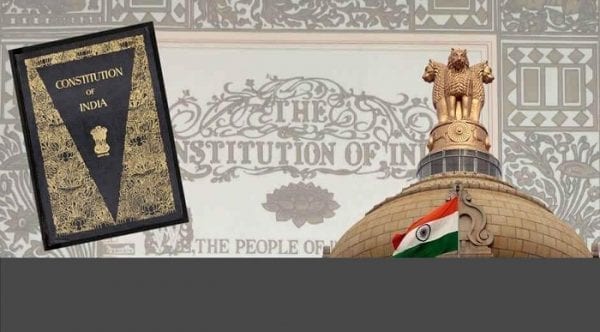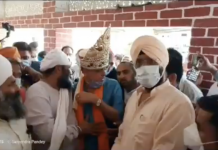- The Constitution of India is the longest written constitution of any independent country in the world. However, the Indian Constitution is known as a bag of borrowings for its varied sources of many features. On Constitution Day, here are the borrowed features in the Constitution.
NEW DELHI, India—With 448 articles in 25 parts, 12 schedules, 5 appendices, and 98 amendments, the Constitution of India is the longest written constitution of any independent country in the world. It was adopted on November 26, 1949, while it came into force on January 26, 1950, when all the members of the Constituent Assembly signed the documents.



The Indian Constitution was not typeset or printed but was handwritten and calligraphed in both English and Hindi by Prem Behari Narain Raizada. The original copies of the Constitution are now kept in special helium-filled cases in the Library of the Parliament of India.
The Indian Constitution is known as a bag of borrowings and draws it features from the Constitutions of many countries. Dr BR Ambedkar rightly said that it was created after ransacking the known Constitutions across the world.
However he also said: As to the accusation that the Draft Constitution has reproduced a good part of the provisions of the Government of India Act, 1935, I make no apologies. There is nothing to be ashamed of in borrowing. It involves no plagiarism. Nobody holds any patent rights in the fundamental ideas of a Constitution.
Despite the borrowed features in the Indian Constitution, it is a unique set of laws that explain the structure and working of the Government of India.
Constitution Day and BR Ambedkar
November 26 is celebrated as the Constitution Day of India or Samvidhan Diwas since 2015, when Prime Minister Narendra Modi marked the while laying the foundation stone of the Ambedkar memorial in Mumbai.
It is celebrated to mark Ambedkar’s birth anniversary, remembering his contribution in the formation of the Constitution of India, and also spread awareness on the importance of the Indian Constitution.
A renowned social reformer, politician and jurist, Ambedkar is called the Father of Indian Constitution. He was appointed Chairman of the Drafting Committee of Constituent Assembly on August 29, 1947.
Ambedkar emphasized on religious, gender and caste equality, and introduced the reservation system in the Constitution of India to create a social balance amongst the classes.
Borrowed features of Indian Constitution
Here are the borrowed features of the constitution of India:
Government of India Act of 1935
1. Federal Scheme
2. Office of Governor
3. Judiciary
4. Public Service Commissions
5. Emergency provisions
6. Administrative details
British Constitution

1. Parliamentary government
2. Nominal Head President (who will perform like the Queen)
3. Post of Prime Minister
4. Lower House more powerful
5. Single citizenship
6. Cabinet system
7. Prerogative writs
8. Parliamentary privileges
9. Bicameral Parliament
10. Speaker of Lok Sabha
11. Rule of Law
12. Legislative procedure
Ireland’s Constitution
1. Concept of Directive Principles of State Policy (Ireland had borrowed it from Spain)
2. Nomination of members to Rajya Sabhaby the President
3. Method of election of President
Unites States of America’s Constitution

1. Written Constitution
2. Impeachment of the President
3. Supreme Court
4. Provision of States
5. Functions of President and Vice-President
6. Removal of Supreme Court and High Court judges
7. Fundamental Rights
8. Judicial review
9. Independence of Judiciary
10. Preamble of the Constitution
South African Constitution
1. Procedure for amendment of the Constitution
2. Election of members of Rajya Sabha
Canada’s Constitution

1. Federation with a strong Centre
2. Vesting of residuary powers in the Centre
3. Appointment of state governors by the Centre
4. Advisory jurisdiction of the Supreme Court
French Constitution
1. The ideals of Republic in the Preamble
2. The ideals of liberty in the Preamble
3. The ideals of equality in the Preamble
4. The ideals of fraternity in the Preamble
Australia’s Constitution

1. Concurrent List
2. Freedom of trade
3. Commerce and intercourse
4. Joint sitting of the two Houses of Parliament
5. The language used in the Preamble
Soviet Constitution (USSR, now Russia)

1. Fundamental duties
2. The ideal of justice (social, economic and political) in the Preamble
3. Five-Year Plans
Germany’s Constitution
1. Suspension of Fundamental Rights during the emergency
Japan’s Constitution

1. Concept of “procedure established by Law”
(Article originally published by India Today @ URL: https://www.indiatoday.in/education-today/gk-current-affairs/story/constitution-day-borrowed-features-in-the-indian-constitution-1622632-2019-11-26 under title Constitution Day: Borrowed features in the Indian Constitution from other countries)




Dear Sir/Madam, there is a factual mistake in youe article. You have mentioned in the article that 26 November is celebarted as Constitutional Day to mark Birth anniversary of Dr. Ambedkar. This statement is wrong as birth anniversary of Dr. Ambedkar in on 14 April. The signifiance of 26 Nov is that, on this day i.e. 26 Nov 1949 the Constituent Assemby adopted the Indian Constitution which later on came into effect on 26 Jan 1950, our Republic Day.
Sanjay Sirsat
Assistant Professor in Law